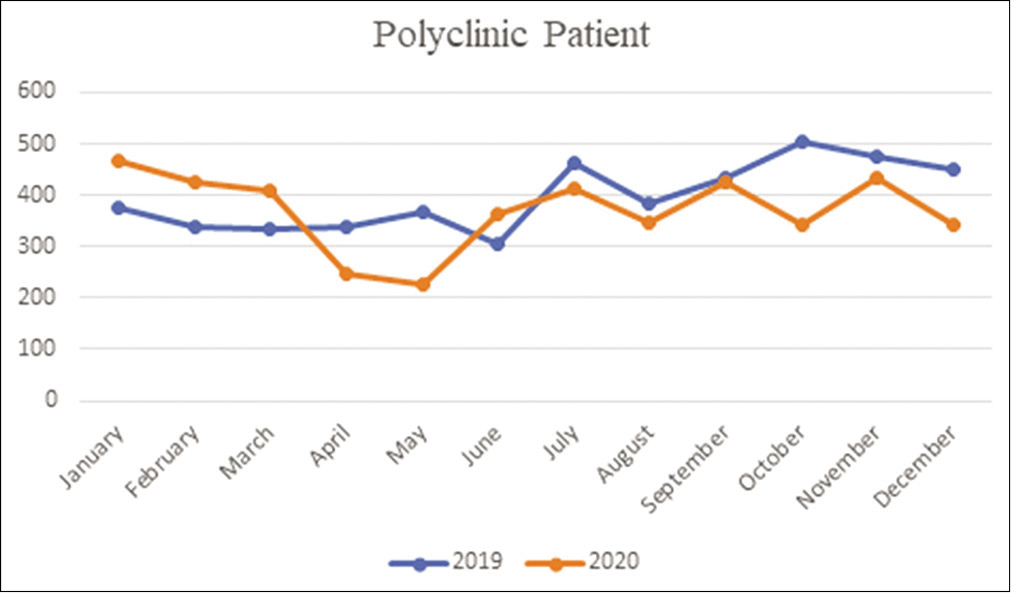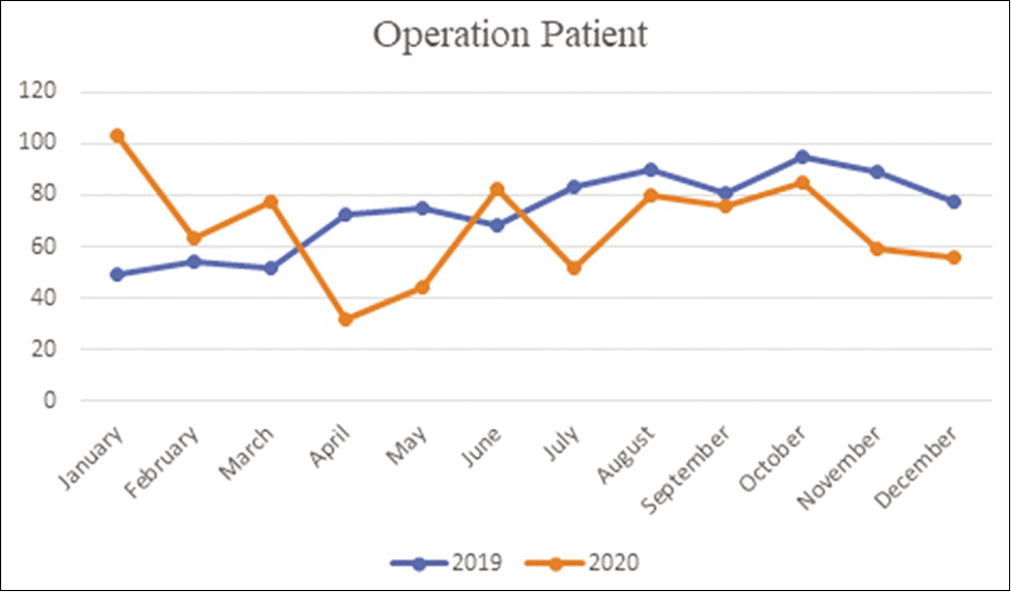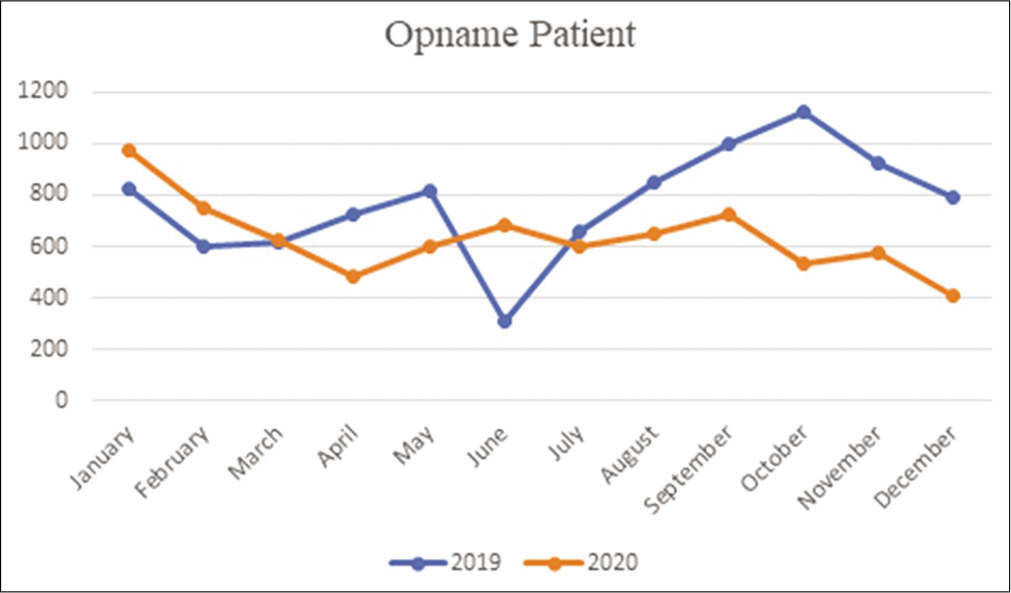- Department of Neurosurgery, Dr. Moewardi General Hospital, Faculty of Medicine University of Sebelas Maret, Surakarta, Indonesia,
- Department of Surgery, Dr. Moewardi General Hospital, Faculty of Medicine University of Sebelas Maret, Surakarta, Indonesia.
Correspondence Address:
Hanis Setyono
Department of Surgery, Dr. Moewardi General Hospital, Faculty of Medicine University of Sebelas Maret, Surakarta, Indonesia.
DOI:10.25259/SNI_150_2021
Copyright: © 2021 Surgical Neurology International This is an open-access article distributed under the terms of the Creative Commons Attribution-Non Commercial-Share Alike 4.0 License, which allows others to remix, tweak, and build upon the work non-commercially, as long as the author is credited and the new creations are licensed under the identical terms.How to cite this article: Hanis Setyono1, Untung Alifianto1, Ferry Wijanarko1, Geizar Arsika Ramadhana1, Galih Santoso Putra2, Muhammad David Perdana Putra2, Ikhdin Saadhi2. The impact of the pandemic on neurosurgical services: A study from a coronavirus disease 2019 referral hospital in Surakarta. 30-Mar-2021;12:128
How to cite this URL: Hanis Setyono1, Untung Alifianto1, Ferry Wijanarko1, Geizar Arsika Ramadhana1, Galih Santoso Putra2, Muhammad David Perdana Putra2, Ikhdin Saadhi2. The impact of the pandemic on neurosurgical services: A study from a coronavirus disease 2019 referral hospital in Surakarta. 30-Mar-2021;12:128. Available from: https://surgicalneurologyint.com/surgicalint-articles/10681/
Abstract
Background: A decrease in hospital visits including neurosurgery cases during the coronavirus disease 2019 (COVID-19) pandemic has been reported by many countries. This study aims to reveal important data regarding the effect that the COVID-19 pandemic has on services, neurosurgical surgery, and inpatients before and during the COVID-19 pandemic.
Methods: This comparative study compares neurosurgical services, neurosurgical patients, outpatient visits, and monthly inpatients assessed from January to December 2020 (onset of the pandemic) with those of the same period in 2019.
Results: The average number of outpatient visits per month during the pandemic (January to December 2020) was 369 visits per month, compared to 397 visits in the same period in the previous year. The lowest outpatient visits occurred in May 2020 with 227 outpatient visits. There was a decrease in the number of neurosurgical patients in January-December during the pandemic period compared to the same period in 2019. A significant decrease in outpatients during and before the pandemic was noted with P = 0.046 (P
Conclusion: There are differences in the number of visits by outpatients, neurosurgical patients, and inpatients during the pandemic compared to the period before the onset of the pandemic.
Keywords: Coronavirus disease 2019 pandemic, Neurosurgical service, Referral hospital
INTRODUCTION
Coronavirus disease 2019 (COVID-19) is an infectious disease that occurs due to the acute respiratory tract infection syndrome of coronavirus-2 severe acute respiratory syndrome coronavirus 2 (SARS-COV2). Based on the history, coronavirus had threatened the society previously causing the SARS outbreak in China. The first COVID-19 case was discovered in December 2019 in Wuhan, China.[
Other symptoms that appear less frequently include cough with phlegm and gastrointestinal complaints.[
Dr. Moewardi General Hospital is a tertiary referral hospital in Surakarta, Central Java, Indonesia. The neurosurgery department in this hospital provides services to patients with trauma, vascular, tumor, neuropediatric, and neuroinfection cases.
Many countries have reported a decrease in total hospital visits since the COVID-19 pandemic.[
This study aims to uncover data showing the effects of the COVID-19 pandemic on neurosurgical services at tertiary referral hospital. The results of this study are expected to be useful for policymakers during the pandemic.
MATERİALS AND METHODS
This is an analytical observational study used a retrospective case-control approach. The total sampling method was used by involving the entire population of neurosurgery patients from January to December 2020 (during pandemic) and January to December 2019 (before pandemic).
Statistical data were analyzed using the Kruskal–Wallis nonparametric comparative test. Analyses were performed using the Statistical Package for the Social Sciences for Windows version 25.0 by IBM in New York, USA. The difference in the number of outpatient visits was statistically calculated and considered significant if P < 0.05. The same method was used to analyze the differences in the number of neurosurgical patients and inpatients in the two periods.
RESULTS
The data collected from tertiary referral hospital in Surakarta were analyzed. The average number of outpatient visits per month during the pandemic (January to December 2020) was 369 visits per month, compared to 397 visits in the same period in the previous year. The lowest outpatient visits occurred in May 2020 with 227 visits. The number of monthly outpatient visits is shown in [
There was a decrease in the number of outpatient visits from January to December 2020 during the pandemic period compared to the same period in 2019, except in January, February, March, and June where the number of outpatient visits during the pandemic was more than that in the same months in 2019. The number of outpatients each month during the pandemic period and the same period in 2019 is shown in [
The number of neurosurgical patients has also decreased. Based on the data collected, 67 operations were performed per month in 2020, compared to the same period in the previous year which amounted to 73 operations per month. The lowest number of neurosurgical operations occurred in April 2020 was 32. The number of monthly neurosurgical patients is shown in [
Based on [
Based on the results of the nonparametric Kruskal–Wallis comparative test data on inpatients at tertiary referral hospital, there was a statistically significant decrease (P < 0.05). [
DISCUSSION
Based on the findings, from January to December during the COVID-19 pandemic, there was a decrease in the number of outpatient visits in each month compared to that in the same period the previous year. The number of outpatient visits, operations, and neurosurgical inpatients in the January-March during the pandemic decreased compared to that in the same period the previous year. Based on the results of the nonparametric comparative test, the result was not significant (P > 0.05). However, there was a decrease in the number of outpatient visits and neurosurgical surgery patients during the pandemic period compared to the prepandemic period.
Our results regarding the number of inpatients in the period before and during the pandemic showed a decrease in the number of inpatients. Based on the nonparametric Kruskal– Wallis comparative statistical test, a statistically significant result (P < 0.05) was obtained for inpatients in the pandemic period compared to the prepandemic period. There was an increase in the number of inpatients in June 2020 (pandemic) compared to June 2019 (before pandemic). The increase in patients in June 2019 before the pandemic could be due to the increase in the number of patients after the national holidays.
Our results show that in January and March 2020 (pandemic period); the number of patients was higher than in the same months before the pandemic [
The results of this study are like a study conducted in Austria by Metzler et al.[
Another study that supports our findings is a study conducted by Lazzerini et al.[
Research from the UK by Thornton[
The decrease in the number of outpatient and neurosurgical visits could be due to the following reasons. First, government regulations impose large-scale social restrictions that were only signed in March 2020. Non-essential activities are limited, and only essential services are allowed, such as shopping centers (households), gas stations, pharmacies, and hospitals. Other activities such as face-to-face schools, concerts, and activities that have the potential to generate crowds are prohibited.
Fewer outpatient and neurosurgery visits at tertiary referral hospital in Surakarta can also occur because of the Decree of the Mayor of Surakarta Number 443.76/28 of 2020 concerning the Determination of the Status of COVID-19 as Extraordinary Events (KLB) in Surakarta City. This had led to a decrease in outpatient and neurosurgical visits from March to April in 2020. The decrease in the number of neurosurgical patients from June to July 2020 and the decrease in the number of outpatient visits from July to August 2020 can occur due to the number of health workers who are positive for COVID-19.
Another factor contributing to the decrease in the number of outpatient and neurosurgical visits is the appeal of the Indonesian Association of Neurosurgery Specialists (PERSPEBSI) in response to large-scale social restrictions. They appealed to the public to postpone visits to neurosurgery or hospitals unless there are emergency conditions such as head trauma and postoperative control patients.
Future research is expected to find out the proportion of decreasing outpatient and neurosurgical visits that are unavoidable, such as conditions that threaten the limb or are life threatening, conditions that cannot be handled in primary health-care facilities, and conditions that require periodic and special observations. There are several limitations to this study, such as the need for more than two research centers to improve the quality of research and enrich data variability.
The advantage of this research is that the use of primary data and research locations as the highest reference for COVID-19 patients.
CONCLUSION
There are differences in the number of outpatient, surgical, and inpatient visits in neurosurgery during the pandemic period compared to the period before the onset of the pandemic.
Declaration of patient consent
The authors certify that they have obtained all appropriate patient consent.
Financial support and sponsorship
Nil.
Conflicts of interest
There are no conflicts of interest.
References
1. Bahl P, Doolan C, de Silva C, Chughtai AA, Bourouiba L, MacIntyre CR. Airborne or droplet precautions for health workers treating coronavirus disease 2019?. J Infect Dis. 2020. 1: 189
2. Hartnett KP, Kite-Powell A, DeVies J, Coletta MA, Boehmer TK, Adjemian J. Impact of the COVID-19 pandemic on emergency department visits United States, January 1, 2019-May 30, 2020. MMWR Morb Mortal Wkly Rep. 2020. 69: 699-704
3. Lazzerini M, Barbi E, Apicella A, Marchetti F, Cardinale F, Trobia G. Delayed access or provision of care in Italy resulting from fear of COVID-19. Lancet Child Adolesc Health. 2020. 4: e10-1
4. MacIntyre CR. Global spread of COVID-19 and pandemic potential. Glob Biosecur. 2020. 1: 55
5. Metzler B, Siostrzonek P, Binder RK, Bauer A, Reinstadler SJ. Decline of acute coronary syndrome admissions in Austria since the outbreak of COVID-19: The pandemic response causes cardiac collateral damage. Eur Heart J. 2020. 41: 1852-3
6. Rothan HA, Byrareddy SN. The epidemiology and pathogenesis of coronavirus disease (COVID-19) outbreak. J Autoimmun. 2020. 109: 102433
7. Tam CF, Cheung KS, Lam S, Wong A, Yung A, Sze M. Impact of coronavirus disease 2019 (COVID-19) outbreak on st-segment-elevation myocardial infarction care in Hong Kong, China. Circ Cardiovasc Qual Outcomes. 2020. 13: e006631
8. Thornton J. Covid-19: A&E visits in England fall by 25% in week after lockdown. BMJ. 2020. 369: m1401
9. Wong LE, Hawkins JE, Langness S, Murrell KL, Iris P, Sammann A. Where are all the patients? addressing Covid-19 fear to encourage sick patients to seek emergency care. NEJM Catal Innov Care Deliv. 2020. 2020: 3











